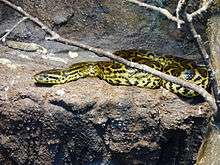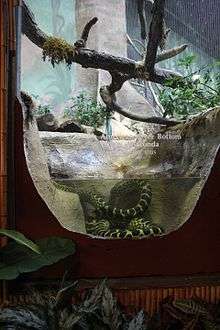Yellow anaconda
| Yellow anaconda | |
|---|---|
| Scientific classification | |
| Kingdom: | Animalia |
| Phylum: | Chordata |
| Class: | Reptilia |
| Order: | Squamata |
| Suborder: | Serpentes |
| Family: | Boidae |
| Genus: | Eunectes |
| Species: | E. notaeus |
| Binomial name | |
| Eunectes notaeus Cope, 1862 | |
| Synonyms | |
| |
The yellow anaconda (Eunectes notaeus), also known as the Paraguayan anaconda[1] is a boa species endemic to southern South America. It is one of the largest snakes in the world but smaller than its close relative, the green anaconda. Like all boas and pythons, it is non-venomous and kills its prey by constriction. No subspecies are currently recognized.
Etymology
The genus name Eunectes derives from Greek and means "good swimmer"; the Neo-Latin specific name notaeus derives from Greek νωταίος/nōtaios (poetic form of Greek νωτιαίος/nōtiaios), here meaning “dorsal”. In distinguishing his new species Eunectes notaeus from Eunectes murinus, Edward Drinker Cope stated, "Dorsal scales are larger and in fewer rows."[2]
Description
Adults are not as large as the green anaconda (E. murinus), but nevertheless grow to an average of 3.3 to 4.4 m (10.8 to 14.4 ft) in total length. They commonly weigh 25 to 35 kg (55 to 77 lb), though large specimens can weigh 40 to 55 kg (88 to 121 lb) or even more.[3] Female yellow anacondas have reportedly been measured up to 4.6 m (15.1 ft).[1][4] Females are generally larger than males.[5]

The color pattern consists of a yellow, golden-tan or greenish-yellow ground color overlaid with a series of black or dark brown saddles, blotches, spots and streaks.[1]
Distribution and habitat
The yellow anaconda is found in southern regions of South America, including Paraguay, southern Brazil, northeastern Argentina, and Bolivia.[6] It appears to have been introduced in Florida, although it is unknown whether the small population (thought to derive from escaped pets) is reproductive.[7] This species prefers mostly aquatic habitats, including swamps, marshes, and brush-covered banks of slow-moving rivers and streams.[5]
Ecology
Yellow anacondas are known to be able to prey on relatively large game, such as brocket deer or peccaries.[5] Observations and analysis of gut and waste contents from regularly flooded areas in the Pantanal region of southwestern Brazil indicate the species is a generalist feeder that employs both ambush predation and wide-foraging strategies. The snakes forage predominately in open, flooded habitats, in relatively shallow water; most predation instances occur from June to November, when flooded areas have noticeably dried out and wading birds are the most common prey. They have also been known to prey on fish, turtles, small caimans, lizards, birds' eggs, small mammals and fish carrion. The prey-to-predator weight ratio is often much higher than for other types of Boidae.[8]
The yellow anaconda has few predators. Juveniles and the occasional adult may be taken by caimans, larger anacondas, the jaguar, some canids such as the crab-eating fox, mustelids, and raptors. The species is being hunted by humans for its skin.[7]
Interactions with humans

In captivity the species has a reputation for being unpredictable somewhat dangerous to humans.[1][5] In the United States, the import, transportation and sale of the species across state lines were banned in 2012 to try to prevent the yellow anaconda from becoming an invasive species in areas such as the Florida Everglades.[9] The conservation status of the yellow anaconda has not been assessed by the IUCN.
See also
- List of boine species and subspecies
- Boinae by common name
- Boinae by taxonomic synonyms
References
- 1 2 3 4 Mehrtens JM. 1987. Living Snakes of the World in Color. New York: Sterling Publishers. ISBN 0-8069-6460-X.
- ↑ Cope, E.D. (1862). Synopsis of the species of Holcosus and Ameiva, with diagnoses of new West Indian and South American Colubridae. Proceedings of the Academy of Natural Sciences Philadelphia 14 [1862]: 60–82.Archive, PDF.
- ↑ Mendez, M; Waller, T; Micucci, P; Alvarenga, E; Morales, JC (2007). "Genetic population structure of the yellow anaconda (Eunectes notaeus) in Northern Argentina: management implications". In Robert W. Henderson and Robert Powell. Biology of the Boas and Pythons (PDF). Eagle Mountain Publishing. pp. 405–415. ISBN 0972015434.
- ↑ Owen, W. (2004). "Snakes: Reptiles". In J Flew, L Humphries. The Encyclopedia of Animals. 1. Los Angeles: University of California Press. p. 397.
- 1 2 3 4 Colthorpe, Kelly (2009). "Eunectes notaeus". Animal Diversity Web. Retrieved 2016-02-03.
- ↑ "Eunectes notaeus". Integrated Taxonomic Information System. Retrieved 2008-07-03.
- 1 2 "Eunectes notaeus". NAS - Nonindigenous Aquatic Species. United States Geological Survey.
- ↑ Strussmann, C (June 1997). "Feeding habits of the yellow anaconda, Eunectes notaeus Cope, 1862, in the Brazilian Pantanal". Biociencias. 5 (1): 35–52. Retrieved 2008-10-06.
- ↑ Segal, Kim (January 17, 2012). "U.S. bans imports of 4 exotic snake species". CNN.
External links
| Wikimedia Commons has media related to Yellow anaconda. |
- Eunectes notaeus at the Reptarium.cz Reptile Database. Accessed 4 July 2008.